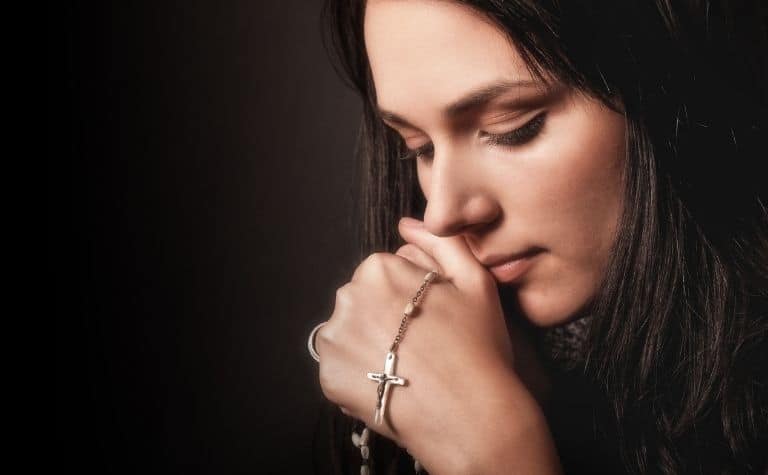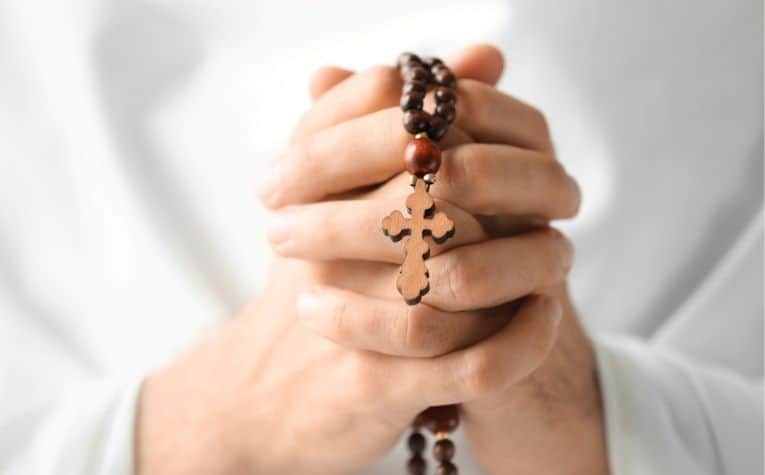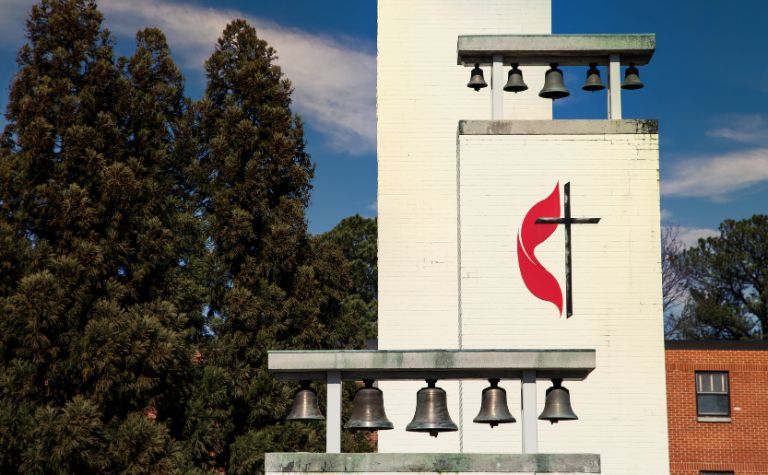Prayer has always been important in Methodism. John Wesley (1703-1791), the founder of the Methodist tradition, once said, “God will do nothing but in answer to prayer.” Yet not all Christians pray the same way. Some people use prayer beads or rosary beads to help guide their prayers. Do Methodists?
Methodists don’t use “rosary beads” in prayer, but few use “prayer beads.” Some Methodists find that using beads helps guide their prayers, though they don’t say the “Hail Mary” prayer like Catholics because they don’t pray to Mary. The Methodists that use beads prefer the name “prayer beads.”
How do Methodists who use prayer beads defend their use? What exactly is the difference between rosary beads and prayer beads? Is there any truth to the rumor that John Wesley used prayer beads? Keep reading to learn more.

Do Methodists Use Prayer Beads?
Many Christians, even those who desire to develop a rich prayer life, struggle to concentrate while praying. Many Methodists say that fingering stringed beads helps them focus their thoughts while in prayer. (Also see Methodist vs. Catholic: What’s the Difference?)
These Methodists emphasize that while some traditions (even other religions – see below) use beads to say unbiblical prayers (e.g., the Hail Mary), using them to help them focus is compatible with Methodist theology.
Why don’t more Methodists use prayer beads?
Some Methodists don’t feel they need beads to help them pray, but others likely associate the practice with Catholicism and so avoid it.
Protestants, not just Methodists, associate beads with praying to Mary (and other Catholic saints) and a crucifix, which adorned many rosary bead strings. Protestants prefer an empty cross, not a crucifix, to symbolize the resurrection of Jesus Christ.
How do Methodists use prayer beads?
Methodists use prayer beads similarly to how people in other traditions use them. They finger each bead one at a time. Each bead represents a single thought, whether it be praise, an expression of thanks, or a petition for themselves or someone else. (Also see Do Methodists Believe in Purgatory?)
What is the nature of the prayer?
Some bead prayers are prescribed (e.g., the first five beads on a string are to reflect on five of God’s attributes), but others are customized (e.g., a person with three children may use the last three beads on a string to pray for them).
In general, Methodist prayers using beads are less prescribed than other traditions that use them, like Catholicism. (Also see Do Methodists Believe in the Saints?)
What is the biblical basis for using prayer beads?
The Bible doesn’t mention prayer beads. However, some advocates cite verses in which God tells people to do something tangible to help them remember and obey him. (Also see What Bible Translation Do Methodists Read?)
For example, in Numbers 15:37-41, God tells the Israelites to use tassels to help them be faithful to him, “The LORD said to Moses, ‘Speak to the people of Israel, and tell them to make tassels on the corners of their garments throughout their generations, and to put a cord of blue on the tassel of each corner.”
It continues, “And it shall be a tassel for you to look at and remember all the commandments of the LORD, to do them, not to follow after your own heart and your own eyes, which you are inclined to whore after. So you shall remember and do all my commandments, and be holy to your God. I am the LORD your God, who brought you out of the land of Egypt to be your God: I am the LORD your God.'” (ESV)
Do non-Christian religions use prayer beads?
Yes. Some historians believe that prayer beads originated in Africa around 10,000 B.C. as a practice of tribal religions indigenous to the continent. Today, several religions use them, including Buddhism, Hinduism, Islam, Sikhism, and the Bahai religion. [2]
According to the beliefs of each religion, beads may be different colors and sizes and vary in quantity, but they serve a similar practical purpose.

Why Don’t Methodists Pray the Hail Mary?
Methodists don’t say the Catholic “Hail Mary” prayer because it violates their doctrines of Jesus Christ and prayer.
Instead, the mantra “salvation by grace alone, through faith alone in Christ alone” has always been a distinguishing mark of Methodism and all other Protestant traditions. (Also see Methodist vs. Lutheran: What’s the Difference?)
This mantra means that Christ is the believer’s sole mediator and ultimate intercessor, and making petitions to Mary or any other saint is an insult to this truth. In defense of this stance, Methodists cite biblical teaching like,
- Christ is the only mediator between God and people: 1 Timothy 2:5, “For there is one God, and there is one mediator between God and men, the man Christ Jesus.” (ESV)
- Christ is the only intercessor between God and people: Romans 8:34, “Who is to condemn? Christ Jesus is the one who died—more than that, who was raised—who is at the right hand of God, who indeed is interceding for us.” (ESV)
Methodists only pray directly to God
Methodists believe Christians should pray to God directly without any saint, including Mary, assisting them in their petitions. The “Hail Mary” prayer is directed to Mary:
Hail Mary, full of grace,
the Lord is with thee.
Blessed art thou amongst women,
and blessed is the fruit of thy womb, Jesus.
Holy Mary, Mother of God,
pray for us sinners,
now and at the hour of our death.
Amen.
Like other Protestants, Methodists believe that the Bible teaches that Christians should pray to God alone through Christ,
- Believers have direct access to God through Christ: Ephesians 3:12, “In whom we have boldness and access with confidence through our faith in him.” (ESV)
- Believers can confidently approach God through Christ: Hebrews 4:16, “Let us then with confidence draw near to the throne of grace, that we may receive mercy and find grace to help in time of need.” (ESV)

Methodists Have Great Respect For Mary
John Wesley and the Methodists after him held that believers living on Earth should respect and honor Christians no longer living on Earth.
Christians should learn their stories, learn from their successes and failures, and thank God for their service and witness. Believers shouldn’t, however, engage them in prayer.
Article XIV of the Articles of Religion of the Methodist Church states, “The Romish doctrine concerning…worshiping, and adoration, as well of images as of relics, and also invocation of saints, is a fond thing, vainly invented, and grounded upon no warrant of Scripture, but repugnant to the Word of God.”
Do Methodists believe in the saints? Methodists use the term “saint,” but not in the same way the Catholic church does. In Catholicism, a saint refers to a believer no longer living on the Earth who the church has deemed worthy of canonization.
Methodism, like other Protestant traditions, teaches that the term “saints,” as the New Testament uses it, describes believers in general (e.g., Eph. 4:12, Phil. 1:22). (Also see Methodist vs. Pentecostal: What’s the Difference?)
Did John Wesley Use Prayer Beads?
Rumors dating to the lifetime of John Wesley alleged that he used beads while in prayer (though not a “rosary”). In a 1756 letter to Nicholas Norton, Wesley articulated a negative statement about beads.
After one of Wesley’s Methodist ministers said, “A man may be circumcised, count his beads, or adore a cross, and still be a member of your society,” Wesley responded, “I know no such instance in England or Ireland.”
Wesley’s statement implies that people who joined Methodist societies stopped using prayer beads.
Another often-cited reference is from Neville Ward’s book The Use of Praying (Epworth Press, 1967): “Not many [Methodists] know that John Wesley himself used the Rosary; and the one he used is at present to be found among the archives of The Leys School, Cambridge” (The Use of Praying, Epworth Press, 1967).
Yet in Michael Rear’s book Walsingham: Pilgrims and Pilgrimages (St Paul’s Publications, 2011), the argument is made that the bead string in question dates to the 19th century, well after Wesley died. [3] (Also see Do Methodists Celebrate Lent?)
References:
[1] Source
[2] Source
[3] Source
Related Questions
Methodism is a prominent branch of Protestant Christianity that dates to the mid-18th century. Pentecostalism is a movement within Protestantism that originated in the early 20th century. What's the...
Methodism and Lutheranism are two of the most influential Protestant Christian denominations. Many of their core beliefs are the same, yet they also have critical theological...
